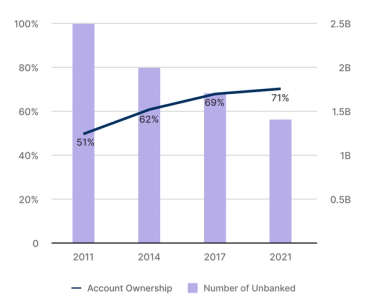Blog Article
It's expensive to be poor
Author
Professor Olayinka David-West
Publishing date
Financial inclusion
Access
Professor Olayinka David-West is an academic and thought leader in the intersection of business management and technology. She leads the Sustainable and Inclusive Digital Financial Services (SIDFS) initiative, a research and advocacy initiative dedicated to enhancing financial inclusion in Nigeria.
Imagine a world where your only means of exchange is cash; that is where you can only physically exchange value. A world where you lack a store of value linked to a payment card (debit or pre-paid), a world where you have no access to extra monies when in need for consumption or other emergencies, a world where if you have any extra money, your notes and coins are in a hidden and locked box. And if you have dependents in remote locations, you must entrust it to someone to carry.
These money propositions – a means of exchange and a store of value – are elusive to 1.4 billion adults worldwide. However, it’s not all doom and gloom. Since global measures began in 2011, Figure 1 illustrates the progress – increased account ownership in formal financial institutions and fewer unbanked adults.

Some of you may be wondering why this is important. The 2014 Global Findex states, “Financial inclusion has been broadly recognised as critical in reducing poverty and achieving inclusive economic growth.” It’s a social scourge that supports the narrative that “it’s more expensive to be poor”. And this poverty is beyond economic poverty; it’s multidimensional poverty encompassing healthcare, hunger and nutrition, potable water and electricity, little or no education or schooling, decent work and livelihoods. The list continues and is our Sustainable Development Goals (SDGs).
The 1.4 billion people unable to access formal financial services are vulnerable to risks and economic shocks or pay more. For example, they risk loss (including theft and damage) when paying with cash, subscribing to informal savings schemes where the collector may abscond or investing through Ponzi schemes. They can only access credit from predatory lenders at higher interest rates, and their lack of protection increases their vulnerability to economic, environmental and health shocks.
In this same world exist numerous depository, non-depository, and investment financial institutions with assets of almost USD 500 trillion1.
Let’s not forget about the more than 11.8 billion mobile connections, more than half being unique subscribers2 and 5.18 billion internet users (to put it in perspective, that’s two-thirds of the global population).
Between 2011 and 2014, digital solutions like mobile money reduced exclusion by 700 million adults. Notwithstanding, barriers to account ownership, which vary from market to market, include environmental, regulatory supply- and demand constraints, as highlighted in Figure 2.

Figure 2: Key financial inclusion barriers
The myth of the silver bullet of digitalizing business and commerce has yet to solve financial exclusion. While digital financial services like mobile money are closing the exclusion gap and reducing geographical limitations and costs, digital exclusions such as access to mobile phones and mobile data communications persist. Even though emerging digital technologies are providing rays of hope and new opportunities to rethink and rebuild traditional approaches to accessing banking services, managing and verifying identity, digitizing (tokenizing) physical assets and lending, these solutions are needed now.
This requires ecosystem grit, resolve, and the mantra, “It takes a village to raise a child”. At the ecosystem's core are responsible financial service providers transforming financial access through new business models, applications, processes, and products and promoting inclusive financial sector development. This core is supported by actors like consumers (individuals, businesses and government agencies), partners and service providers offering novel digital and financial solutions and infrastructure.
Finally, the broader ecosystem requires the participation of actors like the government and regulatory authorities to create an enabling and sustainable environment, academia and development and standard-setting organizations.
In conclusion, we must imagine and build a world where financial access is mainstream and accessible to all, irrespective of socioeconomic status.
Professor olayinka david-west is an academic, thought leader in the intersection of business management and technology. she leads the sustainable and inclusive digital financial services (sidfs) initiative, a research and advocacy initiative dedicated to enhancing financial inclusion in Nigeria.
Sources
1 Financial Stability Board. (2022). Total assets of financial institutions worldwide from 2002 to 2021, by institution type (in trillion U.S. dollars). Statista. Statista Inc.. Accessed: August 31, 2023. https://www.statista.com/statistics/421221/global-financial-institutions-assets-by-institution-type/
2 https://www.gsmaintelligence.com/data/